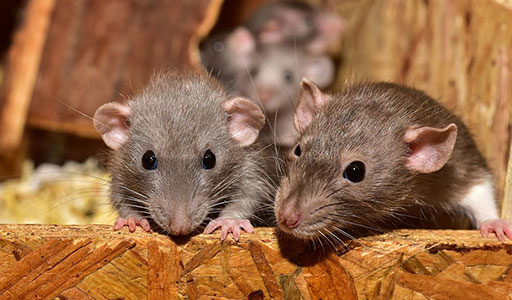Rodent Control in Charlotte
Do you need to get rid of rats or mice? We can help!
Some Geographic Restrictions

Rodent Control Strategies
Rats and mice are not only the most common pest animal in the United States, but also some of the most destructive. Rodents cause property damage, spread diseases, and contaminate your food.
The most common rodents in North Carolina are the house mouse and Norway rat. But roof rats, deer mice, squirrels, and chipmunks also cause problems for homeowners.
Rats and mice are insidious pests. They can squeeze through tiny holes. If they don’t find an entry point, they gnaw through materials like wood, aluminum, lead, and cinderblock. Their high reproduction rate and ability to get through most home materials make rodent population control difficult.
Let Trutech in to get rodents out. Our rodent control program includes rodent traps, bait stations, whole home exclusions, remediation, and on-going pest control to keep rodents out of your house.
Professional Rodent Control

Rodent Traps
Proper placement of trap is essential for effective rodent control. Trap placement depends on what rodent species, how many rodents, how long the infestation has lasted, and what the condition of the property. A few traps haphazardly placed is not an effective means for control.

Exclusion & Control
Once the population is controlled inside the house, exclusions keep them out. Rats can squeeze through a 1/4 inch size hole. Seal cracks and openings in building foundations and any openings for water pipes, electric wires, sewer pipes, drain spouts, and vents. Rats cam gnaw away materials like wood, caulk, plastic, and aluminum.

Monitoring and Maintenance
Rats and mice leave pheromone trails that other rodents follow to find food sources or safe places to nest. Other rats can find their way to your property. Our monitoring and maintenance program keeps the rat or mouse population under control outside your home to keep you and your family protected.
Rat Problems

Signs a Rat Infestation
Rats and mice are the ultimate pests: they do destructive damage and spread disease while breeding at an alarming rate. Rats and mice are nocturnal and avoid people, but you can find physical evidence. The most obvious signs of a rodent infestation are droppings, smudge marks along baseboards, and gnaw marks. You might hear scurrying noises or smell unpleasant odors if rats or mice are well established.

Dangers of Rat Infestation
Rodents are known to transmit more than 35 diseases, breed at a staggering rate, and commonly invade homes, set up nests, and pillage pantries .Rats will gnaw on any material in your home. It becomes a serious issue when rats gnaw on electrical wires. Frayed electrical wires can significantly increase house fires. Once rodents have entered your house and located sources of food and water, they will start building a nest. Rats use anything they can to build a nest—paper, clothes, insulation, you name it. Rats might even start chewing drywall and wiring in their efforts to build a nest; this can cause significant damage to your home and even increase the likelihood of a house fire.
Some Geographic Restrictions
Frequently Asked Questions
Aptly named, rat-bite fever is transmitted through contact with the rodents’ saliva. This, along with Hantavirus, salmonellosis, E. coli poisoning, and leptospirosis, is one of the illnesses people can catch directly from rats. Ticks, fleas, and mites that live in the pests’ fur often ferry rat diseases to humans indirectly.
In addition to the plague, these parasites may carry Lyme disease and Rocky Mountain spotted fever. The pests’ droppings, dander, and fur can also trigger allergic reactions.
There is more than one DIY rat repellent, though none are completely effective.
Popular repellents include:
- Putting out mothballs
- Sprinkling cayenne pepper in gardens
- Enclosing plants with hardware cloth
There are several issues with these approaches. Mothballs only last a short time and can be toxic to pets and small children. The other two rat deterrents may show some results outdoors, but don’t address indoor pests.
Homeowners looking to control infestations are usually offered standard rodent traps such as snap, cage, and burrow entrance traps, as well as glue boards.
Do Rat Traps Work?
This control measure is surprisingly effective. Since the pests are drawn to strange objects in their surroundings, they’re extremely susceptible to traps.
Unfortunately, trapping is not a long-term solution to pack rat problems. Homeowners are better off targeting factors that attract rodents in the first place such as poorly stored food or breaches leading into homes.
Other Issues with Rat Traps
Though rat traps have a higher rate of success than other control methods, this doesn’t mean it’s the best way to get rid of infestations. These animals often host a number of disease-carrying parasites in their fur, which means getting too close can be a health risk.
Also, after
When rats enter homes, they prefer to stay out of sight in undisturbed areas. Identifying a rat infestation, however, is easy, especially as the rodents increase in number. Rats move around a lot and individuals should listen to the sounds of scurrying in attics, false ceilings, and wall voids. These noises intensify at nighttime, as rats are nocturnal and become most active after dusk. Additionally, homeowners should look for rat droppings around sources of food, like pantries, smudge marks on walls left by the greasy, oily fur of rats, and gnawing damage. Finally, residents may spot adult rats in sheltered locations such as storage boxes, seldom-used drawers, and stacks of firewood.
Homeowners may be alerted to the presence of rats in the attic by sounds, sights, and smells. Usually the most apparent signs of infestation are the scratching and scurrying sounds these rodents make. As rats are nocturnal, they are noisiest when individuals are settling in for a night of rest. Additionally, home residents may notice visual cues such as rat droppings, teeth marks in food containers, and even tracks. Finally, the musky smell of rat presence and malodorous collections of droppings and urine are sure indications of rat infestations in the attic.
To detect the presence of rats in walls, residents should remain alert for rat droppings around homes, oily smudge marks, and gnawed holes in walls and food containers. Droppings are long, cylindrical pellets typically dark brown in color that can be found wherever rats frequent.
Smudge marks appear as greasy patches on floors and walls as a result of the pests’ dirty fur rubbing up against a surface.
Finally, rats use their large front teeth to chew access holes into walls and gnaw open food containers. These openings are ragged around the edges and may only be as large as half an inch in diameter.
Since rats are primarily active at night, infestations usually go undetected for some time. However, knowing what rat signs to look for allows property owners to notice the presence of rats
under decks sooner. Telltale signs of rat infestations include scratching and squeaking noises, the presence and smell of urine and excrement, and remnants of nesting materials like ripped up insulation.
A clever way to detect the presence of rats under decks is to place newspaper over the openings. After a few days, if the paper is ripped or gone, property owners should assume they’re dealing with an infestation.


